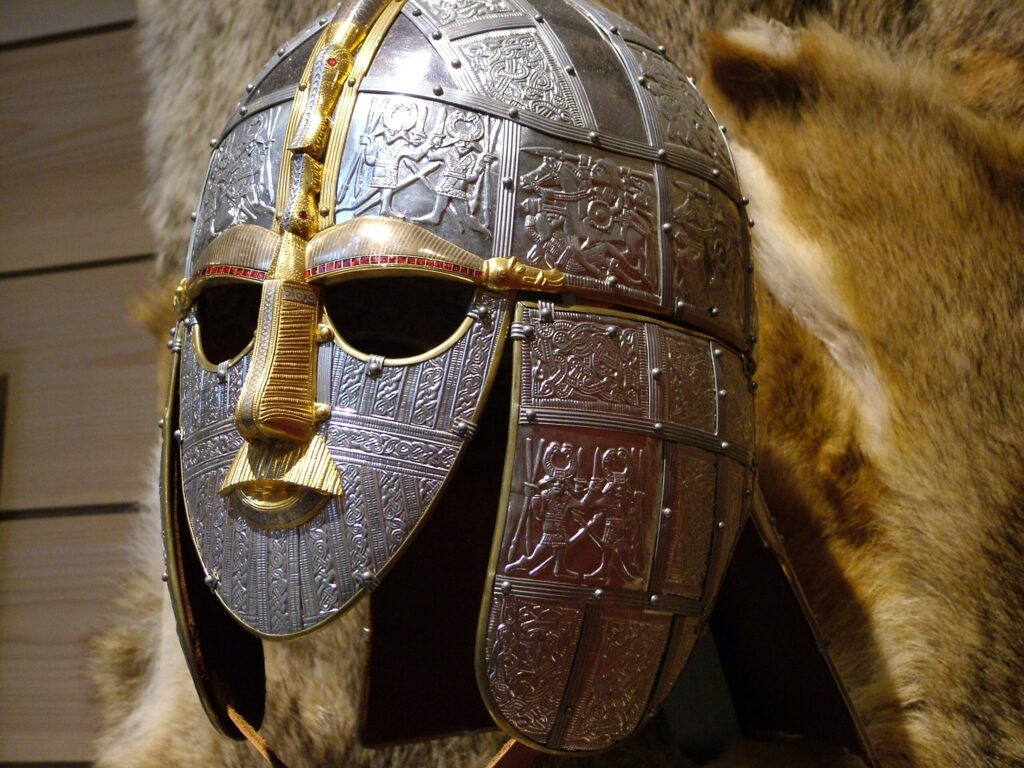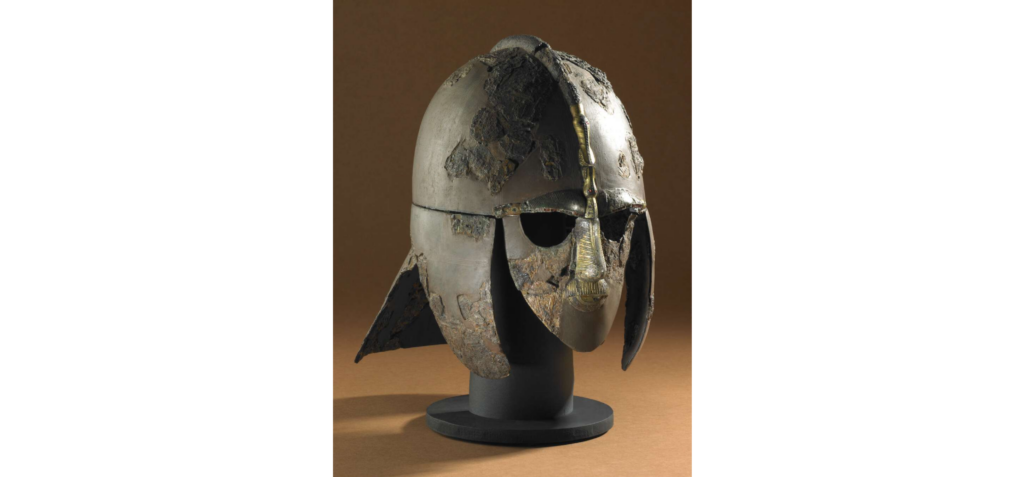The Sutton Hoo Viking helmet is one of the most significant archaeological finds of the 20th century.
Discovered in 1939, the helmet was found in a burial mound at Sutton Hoo in Suffolk, England. The helmet dates back to the early 7th century and is believed to have belonged to a high-ranking Anglo-Saxon warrior.

The helmet is made of iron and tinned copper alloy and is comprised of many pieces of iron. It is now built into a reconstruction that measures 31.8 x 21.5 cm. It is decorated with intricate designs that include fighting and dancing warriors, as well as fierce creatures and is a testament to the skill and craftsmanship of the Anglo-Saxon people as well as being an important artifact in the history of England.
Now on display at the British Museum, the Sutton Hoo helmet has been painstakingly reconstructed by the conservation team.
It is one of only four complete helmets known to exist from the Anglo-Saxon period, making it an incredibly rare and valuable find.
Unearthing the Past: The Discovery at Sutton Hoo
The Excavation: Edith Pretty’s Vision
In 1938, Edith Pretty, a wealthy widow, owned a piece of land in Sutton Hoo, Suffolk, England. She had always been interested in history and archaeology, and she believed that there might be something of historical significance buried on her land. She hired local archaeologist Basil Brown to excavate the site.
Basil Brown’s Remarkable Find
Basil Brown began his excavation in June and July of 1938. He focused on three of the burial mounds, using the traditional technique of cutting a trench across them in search of the chamber or pit. On the 3rd day of the dig, he discovered an Anglo-Saxon ship burial, which contained a treasure trove of artifacts, including a remarkable helmet.
The helmet was made of iron and tinned copper alloy and was decorated with intricate imagery, including fighting and dancing warriors and fierce creatures. It was in many pieces when it was discovered, and it took the conservation team at the British Museum many years to reconstruct it.
The discovery of the Sutton Hoo ship burial was a remarkable find and shed new light on the Anglo-Saxon period. It is now considered one of the most important archaeological discoveries in British history.
The story of the discovery of the Sutton Hoo helmet and the ship burial has recently been popularized by the Netflix movie, “The Dig.” The movie tells the story of Edith Pretty and Basil Brown and their remarkable discovery.
Deciphering the Sutton Hoo Helmet

The Sutton Hoo helmet was discovered in 1939 in a ship burial in Suffolk, England. It was found in many pieces, and it took conservators at the British Museum many years to reconstruct it. The helmet is made of iron and tinned copper alloy, and it consists of many pieces of iron. The reconstructed helmet measures 31.8 x 21.5 cm.
The reconstruction of the helmet was a challenging process. The conservators had to fit together many small pieces of iron, some of which were badly corroded. They also had to recreate missing pieces, such as the face-mask. The face-mask is one of the most striking features of the helmet, and it is decorated with cloisonné work, a technique in which enamel is applied to metalwork.
Symbolism and Artistry
The Sutton Hoo helmet is decorated with intricate imagery that has symbolic meaning. The helmet features a dragon on the crest, which is a symbol of power and strength. The dragon is flanked by two birds, which are likely to represent ravens, a bird associated with Odin, the god of war and death. The helmet also has animal heads on the cheek-pieces, which are thought to represent boars, another symbol of strength.
The decoration on the helmet is a testament to the skill of the Anglo-Saxon craftsmen who made it. The cloisonné work on the face-mask is particularly impressive, with its intricate patterns and vivid colors. The helmet also features delicate filigree work, which is a technique in which gold or silver wire is twisted into intricate patterns.
The Cultural and Historical Significance

King Rædwald and East Anglia
The Sutton Hoo Viking helmet is believed to have belonged to King Rædwald, the Anglo-Saxon ruler of East Anglia during the seventh century. Rædwald was a powerful king who played a significant role in shaping the history of Anglo-Saxon England. He was known for his military prowess and his efforts to expand his kingdom’s influence throughout Europe.
The discovery of the Sutton Hoo helmet sheds light on the cultural and historical significance of Rædwald’s reign. The helmet’s intricate design and craftsmanship suggest that Rædwald placed great importance on military power and prestige. It also highlights the wealth and sophistication of the Anglo-Saxon kingdoms during the Dark Ages.
Christianity and Pagan Beliefs
The Sutton Hoo Viking helmet is a testament to the complex religious beliefs of the Anglo-Saxon people. At the time of Rædwald’s reign, Christianity was beginning to spread throughout England, but many people still held onto their pagan beliefs. The helmet’s design includes both Christian and pagan symbols, such as depictions of warriors and fierce creatures.
The helmet’s combination of these symbols suggests that Rædwald and his people were attempting to reconcile their Christian and pagan beliefs. It also demonstrates the cultural exchange that occurred during the Early Medieval period in Europe.
Legacy and Display

From Sutton Hoo to the British Museum
The Sutton Hoo Viking helmet is one of the most iconic and recognizable treasures of the Anglo-Saxon period. The helmet was found in fragments, which were later pieced together by the conservation team at the British Museum. The helmet is made of iron and bronze, and it is decorated with intricate designs of warriors, animals, and mythical creatures.
After the discovery of the helmet, it was taken to the British Museum for restoration and preservation. Today, the helmet is on display in the Early Medieval European Collections section of the museum. The helmet is a centerpiece of the exhibit, and it is considered to be one of the most important artifacts in the museum’s collection.
Influence on Literature and Media
The Sutton Hoo Viking helmet has had a significant impact on literature and media. The helmet is believed to have inspired the design of the helmet worn by the hero Beowulf in the epic poem of the same name.
The poem describes a helmet that is similar in design to the Sutton Hoo helmet, with a crest and cheek-pieces. The helmet is also believed to have influenced the design of the helmets worn by the characters in the Lord of the Rings movies.
The helmet has also been the subject of numerous books, documentaries, and films. One of the most popular documentaries about the helmet is “The Sutton Hoo Helmet: The Battle for a Priceless Relic”, which was produced by the British Museum.
The documentary tells the story of the helmet’s discovery and restoration. It features interviews with experts, including Sue Brunning, the curator of the Early Medieval European Collections at the British Museum.
The Sutton Hoo Viking helmet is an important artifact that has had a significant impact on our understanding of the Anglo-Saxon period. The helmet’s intricate designs and historical significance make it a valuable treasure that will continue to inspire and fascinate people for generations to come.










Add Comment